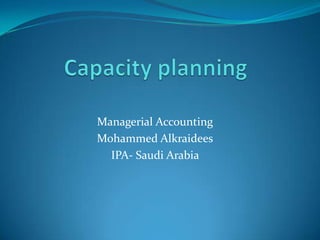Capacity planning
•Download as PPTX, PDF•
10 likes•6,861 views
resource : http://en.wikipedia.org/wiki/Capacity_planning
Report
Share
Report
Share

Recommended
More Related Content
What's hot
What's hot (20)
Inventory Optimization: Action Plan for Inventory Optimization

Inventory Optimization: Action Plan for Inventory Optimization
Viewers also liked
Viewers also liked (20)
A Consolidated Visualization of Wind Farm Energy Production Potential and Opt...

A Consolidated Visualization of Wind Farm Energy Production Potential and Opt...
Presentation outsourcing of business processes in romania dec 2014

Presentation outsourcing of business processes in romania dec 2014
Strategic capacity planning for products and services

Strategic capacity planning for products and services
Similar to Capacity planning
Similar to Capacity planning (20)
Capacity resource planning and production scheduling

Capacity resource planning and production scheduling
Facility_Capacity_Planning_&_its_Measurement_Final[1] - Copy.pptx![Facility_Capacity_Planning_&_its_Measurement_Final[1] - Copy.pptx](data:image/gif;base64,R0lGODlhAQABAIAAAAAAAP///yH5BAEAAAAALAAAAAABAAEAAAIBRAA7)
![Facility_Capacity_Planning_&_its_Measurement_Final[1] - Copy.pptx](data:image/gif;base64,R0lGODlhAQABAIAAAAAAAP///yH5BAEAAAAALAAAAAABAAEAAAIBRAA7)
Facility_Capacity_Planning_&_its_Measurement_Final[1] - Copy.pptx
How to Transform your Capacity Planning Process: Step-by-Step Guide

How to Transform your Capacity Planning Process: Step-by-Step Guide
Capacity planning
- 1. Managerial Accounting Mohammed Alkraidees IPA- Saudi Arabia
- 2. Capacity planning Capacity planning is the process of determining the production capacity needed by an organization to meet changing demands for its products. design capacity. effective capacity.
- 3. The goal of capacity planning The goal of capacity planning is to minimize this discrepancy between the capacity of an organization and the demands of its customers results in inefficiency, either in under-utilized resources or unfulfilled customers .
- 4. Overall Equipment Effectiveness OEE Demand for an organization's capacity varies based on changes in production output, such as increasing or decreasing the production quantity of an existing product, or producing new products. Better utilization of existing capacity can be accomplished through improvements in overall equipment effectiveness .
- 5. Capacity can be increased through : introducing new techniques. equipment and materials. increasing the number of workers or machines. increasing the number of shifts. acquiring additional production facilities.
- 6. Capacity is calculated: Capacity = (number of machines or workers) × (number of shifts) × (utilization) × (efficiency)
- 7. How much to increase capacity demands depend upon a number of factors, including: Anticipated demand – volume & certainty Strategic objectives Costs of expansion and operation
- 8. The broad classes of capacity planning capacity lead strategy . capacity lag strategy . • match strategy . (Average Capacity Strategy)
- 9. capacity lead strategy : In anticipation of demand, capacity is increased. This is an aggressive strategy and is used to lure customers away from competitors. It often results in excess inventory. Costly and often wasteful .
- 10. capacity lag strategy : Increase capacity after demand has increased. It decreases the risk of waste. This is a conservative strategy and may result in lose of customers. You assume customers will return after capacity has been met.
- 11. Average Capacity Strategy : Average expected demand is calculated and capacity is increased accordingly. This is the most moderate strategy.
- 12. Capacity planning is long-term decision Inadequate capacity planning can lead to the loss of the customer and business. Excess capacity can drain the company's resources and prevent investments into more lucrative ventures. The question of when capacity should be increased and by how much are the critical decisions.
- 13. THE END Thank you for your attention..
